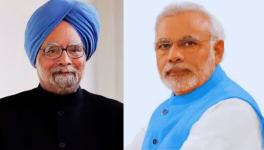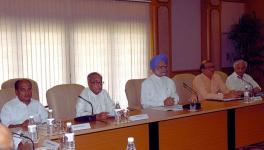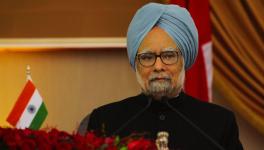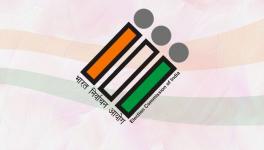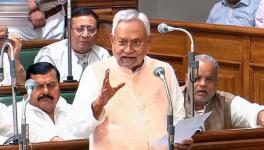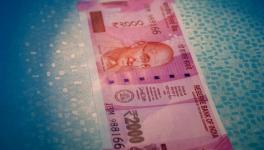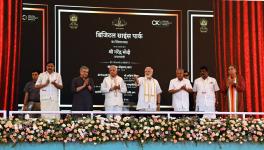CBI Court: A Few People Manufactured a Scam with Selected Facts, No Evidence of Wrongdoing

Newsclick Image by Sumit Kumar
The Judgement by OP Saini, the CBI Judge in the 2G case, makes for strange reading. The judge seems bent on proving that let alone a crime, there is no evidence of a loss to the exchequer; the furore in the case was only due to “media”; and even if there were wrong decisions, by the Department of Telecom, A Raja, the telecom minister was not to blame. He was merely an innocent babe in the woods, misled by the department of telecom officials, who were responsible for all the decisions. To quote the Judgement, “Thus, some people created a scam by artfully arranging a few selected facts and exaggerating things beyond recognition to astronomical levels.” Did these people include the CAG? The Supreme Court? A question that we are left to ponder, with no help from the Judgement.
Let's take a look at the 2G case, as we know it, and not through the looking glass of the CBI Court’s Judgement.
First, the basic elements of the 2G scam -- and we are going to call it a scam in spite of Saini’s 2G Judgement. The question is how we price spectrum, as spectrum is a scarce commodity. In India, the spectrum became a part of the license of the cellular operators, as a certain amount of spectrum was clubbed with the license. Without spectrum, the license has little value, as no cellular operator can provide services.
It is clear that the price of the spectrum in 2001, when the 4th operator’s license had been auctioned, was very different from its market price in 2008, when Raja was handing out the licenses. In 2001, there were only 4 million cellular subscribers; in 2008, it was 350 million. Raja argued against auctioning the spectrum/license and sticking to 2001 prices. In his view, if the price of the spectrum/license is low, the cost of service would also be low, and therefore more affordable to the consumers. If this was indeed the argument for not auctioning the license, the logical step would have been then to provide a lock-in for the new licensees, at least for a period of 3 years. Instead, the Department of Telecom under Raja, explicitly diluted the requirement of such a lock-in and allowed mergers. Worse, it made possible for companies, who had acquired the licenses, to sell significant amount of shares of these companies. The only asset that these companies had was the spectrum/license. In effect, this method of giving out licenses was tantamount to allowing those, who had secured cheap licenses at 2001 prices, to conduct a private auction and realise windfall profits.
Unitech sold its shares to Telenor: 67.25% shares were transferred at a price of Rs. 6,120 crore to Telenor Asia. If we take out the Rs. 1,651 crore Unitech paid for the licenses, it made a windfall profit of three times that amount, while retaining about one third of the shares. Similarly, Swan Telecom sold 45% of its shares for $900 million (or Rs. 4,113 crore) at 2008 prices. Again, they received about two and a half times of what they had invested within a few months, while retaining more than 50% of their shares.
The second obvious issue was the way the licenses were handed out. And there were more than one “arbitrary” decision by Raja on that. He first announced that the licenses will be handed out on a first come first served basis, with the cut-off date for applications as of October 1, 2007. On January 10, 2008, DoT uploaded a new press release stating that the cut-off date would be taken as September 25, 2007. The press release also asked the companies to submit their demand draft – of up to Rs. 1,658 crore – between 3.30 pm and 4.30 pm on same day. The CBI Judge does not seem to have been convinced that if these companies could submit these demand drafts of such high amounts within 45 minutes, this could have happened only if they had advance notice. Finally, as per this press release, those who would get the license on a “first come first served” basis would be determined, not by the application date, but by who had submitted the demand draft first. Neither has the Court bothered to explain how bank guarantees or demand drafts could have been prepared well in advance of the publication of the press release, as can be seen from the dates on bank guarantees/demand drafts. Even after all this, the Court decided that there was no evidence of a conspiracy or collusion between the companies and the accused, A Raja.
Another issue that again the Court appeared to have ignored that companies such as SWAN Telecom and Loop Telecommunications fulfilled the requirements of capital only by taking huge amounts of money from Anil Ambani Reliance and Essar (Ruias), that they were in effect benaami companies of Anil Ambani and the Ruias. On the face of it, the most important case of corruption of the millennia has now fizzled out. The Judge refused to accept any evidence of a conspiracy, that the CAG and the Supreme Court had found which led to huge losses for the exchequer. If the Judgement is to be accepted, the entire cast of ministers – from the then Minister of Communications and IT, A Raja, to P.Chidambaram, the then Finance Minister, the Prime Minister – were duped by a few low ranking officials in the Department of Telecom. And apparently, even if they had done it, it was not because of any conspiracy to defraud the exchequer, and benefit from the companies concerned, but because they were completely incompetent.
In all cases of corruption, we should look at who benefited. Yes, Raja and the DMK were part beneficiaries, as we can see from the Rs. 200 crore that travelled from Swan Telecom of Shahid Balwa, to Kalaignar TV belonging to the Karunanidhi family. But the bigger beneficiaries were the big corporate houses – the Ambanis, the Ruias, the Chandras (Unitech). And those like Tatas and again Ambanis, who benefitted from the cross-over license – allowing companies who held CDMA license to buy GSM license – again at 2001 prices. And finally, Airtel and Vodafone, who again secured cheap spectrum from Raja and the Department of Telecom. These are also the beneficiaries of the current regime as well.
If we thought that the courts will protect us against the depredations of the existing political system, the 2G Judgement comes as a big blow.
For more news on 2G scam, Anil Ambani group and spectrum auction, read following stories:
Anil Ambani Emerges from the Shadows of Modi’s Rafale “Deal”
Claiming Victory in Defeat: The Spectrum Auction Fiasco
Chacko's Report on 2G Scam Destined for the Dustbin
The 2G Judgement Dismisses Sibal's No-Loss Argument
The 2G Judgement: Holding Corporate Houses also Accountable
The New 3G Scam: Har Friend Zaroori Hota Hai
2G Scam - Chidambaram's role officially acknowledged
The 2G Scam: Arithmetic According to Kapil Sibal
Paranjoy Guha Thakurta on the Telecom Scam and CAG Report
Get the latest reports & analysis with people's perspective on Protests, movements & deep analytical videos, discussions of the current affairs in your Telegram app. Subscribe to NewsClick's Telegram channel & get Real-Time updates on stories, as they get published on our website.










